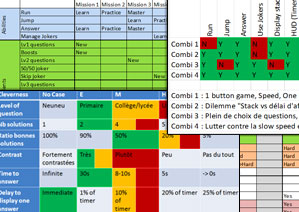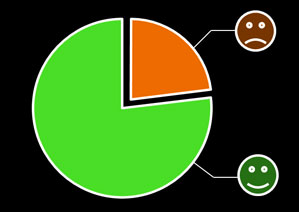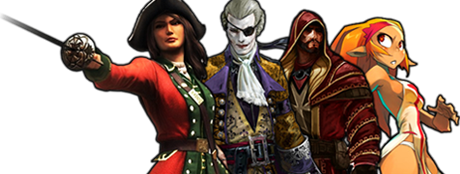Game Design
Game Design
Production skills
Presentation / Management
Level Design & Level Building
Level Design / Level Building
Script & programming
Web programing / Script
Extra skills
Other useful knowledge

Game design
I have been trained to game design in general at Supinfogame then started building my professional at Ankama then Ubisoft on Assassin's Creed Multiplayer.
I have known two complete productions and so I have experience of all the steps of the production, from the early design concepts to the last tweaks, including feature presentations to team, design brainstorms, playtest monitoring.
My experiences at Ubisoft and Ankama gave me a good understanding of online features and social mechanics and I could work on a wide range of features: features directly related to gameplay like contextual kills, character behavior, and others like character customization, postlaunch in-game events or storyline.

Rational game & level design methods
At Ubisoft, I have been trained to Rational Design methods. Basically, the aim of this method is to break down the game mechanics in different layers of atomic parameters, those being the different switches that can be activated and tweaked to change the experience.
It is very useful to highlight interactions between mechanics, the way they may work together (or interfere) and to build progression and lurning curves. As an example, I used this method to clearly identify the game mechanics of Assassin's Creed Multiplayer, sort them then dispatch them on different tables to design the tutorials of AC4 Black Flag.
With this method, game and level design are closely linked and it becomes a very powerful communication tool to improve the collaborative between game and level designers.

Accessibility and tutorials
While working at Ubisoft, I designed and implemented the tutorials of Assassin's Creed III and Assassin's Creed IV Black Flag Multiplayer. By iterating on these tutorials, studying statistics and players' behavior during playtests, I understood the key principles of tutorials design: introduce the basics so that the players can play by themselves as soon as possible without getting them bored with too many details, and, most important, bring them entertainment and challenge as soon as possible. A tutorial is not all about learning: it is the very last teaser before the actual game.
Accessibility is also a key principle in a game. It is a very tricky part (accessibility should not mean easiness) that can come only with a combination of easy-to-get, consistent design rules and crystal clear signs and feedbacks.

Agile methods & management
During my experience as a project manager on Alife, I worked with tools and methods inspired by different Agile methods such as SCRUM. The idea is not to apply blindly existing methods, but to adapt them to the specificities of the team and the project.
Agile methods promote direct communication over an overload of documents, favor reactivity and adaptability without disdaining long-term planning and aims at optimizing collaboration between teams.
Daily and weekly meetings help communication and prevent misunderstandings as frequent discussions and short meetings does over mail debates. Backlog and user stories are great tools to make everyone work on the same page, as it is a common tool for anyone in the production Ė management, design, development and QC.

Presentation
For a game designer, it is essential to be able to communicate ideas efficiently: finding exciting mechanics is pointless without the ability to sell them and convince people why it is worthy. To do so, I have studied and experimented presentation methods, to understand the essential keys of argumentation and to expose ideas efficiently. My main inspiration is the Zen method, that focuses on the speaker, the relevancy of the speech and the suggesting power of the pictures over long texts.
More than a simple presentation method, this becomes handy in various domains and the key principles of the Zen method can also be used as an inspiration when building game mechanics of interfaces for instances, to make it as efficient and accessible as possible.

Documentation
Especially in big companies and multi-site productions, direct discussion with all the people implied in the development is not always possible and it is essential to deliver complete, clear and efficient documents.
Documentation is for me an essential part of a designer job and I use my skills in the MS Office Suite advanced features as well as my knowledge in presentation and accessibility to create appealing documents that fit with the targeted peopleís needs.
As good documentation prevents misunderstanding and mistakes, motivates people to work and keeps ideas safe even when the author is missing, it is a key point that should not be neglected in a production.

Level-design
A good game mechanic can be spoiled by a bad level-design, or transcended by a good one. Level and game design are for me closely linked and share the same goals.
I used to create 3D level-design for personal projects (e.g. mods for Elder Scrolls games) then during my studies at Supinfogame (e.g. work on UDK for Gears of War). Then, I applied my knowledge to 2D strategic game when working at Ankama on Wakfu MMO.
I have also been trained to rational level-design at Ubisoft, a method aimed at breaking down the game mechanics to spread them wisely through the levels and mix them cleverly to create variety or exotic gameplay without changing the game design of the mechanics themselves.

Level building
Building levels on 3D editors for the games I was playing (mainly the Elder Scrolls) was the first step I did in the video game creation. I am convinced by the power of level building in games from both a gameplay and story point of view.
From a gameplay point of view, level building is more than simply creating a beautiful workshop for the player, it is also a tool to communicate to him, give him hints about what to do, how to do it. Gameplay constraints are for me as important as visual or architectural considerations: any asset should have both a visual and gameplay signification.
From a story point of view, interesting details set in the world at the right place and a consistent environment that ignite playerís curiosity can tell more than a document or audio file put on the playerís path. As it is a bridge between gameplay and story, I have always been interested in level-building.
At Ankama, I learnt to work under strong gameplay and visual constraints, as environments were already existing in other media like the TV show and because of the specificities of MMOs. For more info about my experience as a level-builder at Ankama, please check the Games section.

Programing
Along with video-games, I am also passionate by web-design and created websites on various topics. My studies at the university were focused on web creation and I did a three-month internship as a web-programmer at Digital Stream Ltd (Auckland, New Zealand). I am still programing websites using XHTML, CSS, PHP, MySQL, JavaScript languages.
This knowledge of web programing gives me a good understanding of the development of a game and becomes helpful when discussing with programers. Thanks to this, I am also able to write and edit scripts when required in my design tasks. For instance, in Assassinís Creed Multiplayer, I edited and created some scripts to run on the server to do post-launch gameplay updated.

Scripting
Scripting is quite frequent for a game or level designer. As an example, during my work at Ankama, I wrote scripts in LUA to create quests, trigger specific events or FX depending on players' actions to make the world react and give it a living and responding feeling.
I am also used to visual scripting thanks to my work on UDK (Kismet system) at Supinfogame, on The Elder Scroll Construction Set for personal projects or while implementing tutorials for two of the Assassin's Creed Multiplayer games.
Thanks to my knowledge in programing and these experiences, I can easily adapt myself to any script language or game editor.

Summary
Thanks to my personal works and my studies at the University of Dijon, I had the chance to get introduced to all the aspects of the production of multimedia products. Even if I definitely not have the pretention to be able to assume a profesional job in any of these domains, I have some basic knowledges in marketing and communication, 3D and 2D graphic design.
These knowledge help me in my every-day work as a game-designer. It allows me to understand in the main lines all of the aspects of the production. When I am designing a feature, I can do it considering the constraints of the teams who will be involved in the development of this feature and anticipate potential issues - or quick wins.

Basic 2D graphic design knowledge
As a web designer, I use both bitmap (Photoshop, Gimp), and vectorial (Illustrator) graphic design software to create website skins, icons, banners and so on. Letís be clear: I do not pretend having good artistic skills, but thanks to my knowledge of this software, I can create mockups for design documents, illustrate document for internal communication with appealing stuff and do quick retakes on game assets if needed.
For instance, on Assassinís Creed Multiplayer, I had to edit, crop and retake pictures to create icons for customization items and assets for the story files given to the players, and I could work quite quickly on this, especially as I knew how to run scripts in Photoshop.
During my studies at Supinfogame, I created with Illustrator the entire graphic design of a full set of cards for a board game. I also created various marketing documents for our student game and improved our final presentation with appealing graphics.

Basic 3D graphic design knowledge
Letís be clear from the beginning, my capacities in 3D are very low. But I did work on 3D projects, for personal work or during my studies, and I understand how it works and what are the main constraints of such productions. It comes in handy when I have to discuss with animators or 3D artists (as I did in Assassinís Creed Multiplayer as I was the designer attached to the character/animation team), at least to understand their constraints Ė or simply what they say.
I used 3DSMax, Blender and Maya.






